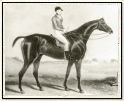| |
|
|
|
|
Half-Bred Family Quick Links
|
|
|
|

|
|
|
|
|
Family B-14: Jupiter Mare
 |
This is the family of the famous Lottery, winner of the first Grand National steeplechase to be held over the Aintree course at Liverpool in 1839. The earliest known mare in the family was a Welsh pony, the dam of a daughter by Jupiter, who produced a filly by Staghunter. The Staghunter mare's daughter, by Grog, produced two fillies, Parthenia, by the Soothsayer son Welbeck, dam of Lottery (see below), and Josephine, a filly by Napoleon le Grand, a half-bred son of Blacklock's. Josephine was unraced, as was her daughter, The Gift, by Maroon. The Gift produced the brown colt Riston, a winner of two hurdle races and eighteen steeplechases, the last run at the age of fifteen. Her daughter, by Mappleton, had two daughters that bred on: a mare by Tally Ho, who produced a good Yorkshire point-to-point winner named Owbridge, and Gleam, a hunter who produced several foals. The family was mostly developed by Peter Jackson of Riston Grange, Hull, and then by John Jackson of Whitecross, Beverley.
|
Notable Descendants
|
 |
| Lottery
|
|
|
Lottery br.g. 1829
(Lottery - Parthenia by Welbeck)
Lottery was a tough, game steeplechaser who gained such fame that he was severely penalized by weight in his later career, and even banned from competing because of his successes. He was bred by Peter Jackson of Riston, Hull, and sold as a leggy, narrow colt to John Elmore at the Hornscastle Fair in 1836. He was used as a hunter with stag hounds, and then put to steeplechasing. He ran for eight seasons, winning two flat races, five hurdle races and at least fourteen steeplechases, including the Grand National inaugural chase over the Aintree course in 1839. He was owned throughout his career by John Elmore (also owner of Grand National winner Jerry), ridden by the famous chasing jockey Jem Mason, who became Elmore's son-in-law, and trained by George Dockeray at Epsom. After his retirement, in 1844, he was used by Dockeray as a hack, and later by Henry Hall, who had a pack of harriers at Neasden, to whom he was lent by Elmore, a neightbor. Towards the end of his life he was used as a cart horse when he was "too much played-out to stand cross-country work," and when he died was buried at Astley Grange Farm stud at East Langton, Leicestershire. For a more complete snyopsis of his career and life, see Lottery.
His sire was the great stayer and weight-carrier, Lottery, who carried on the Joe Andrews branch of the Eclipse sire line, and who got the great broodmare Alice Hawthorn and several classic winners and sire sons that bred on, most notably Sheet Anchor. He also had a signficant influence on jumping lines.
His dam, Parthenia, was bred by John Jackson of Whitecross, Beverley, and ran unplaced in a hunters' stakes for "horses not thoroughbred" at Beverley. She was by Welbeck, a son of Doncaster Stakes and St. Leger winner Soothsayer, who was a leading sire in the U.K. in 1819, and was later sold to Russia. Welbeck, a son of Pledge, out of the famous broodmare Prunella, was also sire of Bedlamite (1823), unbeaten as a juvenile, third in the St. Leger and winner of the Richmond and Northallerton Cups. In addition to Lottery, Parthenia produced Hamlet, by Young Phantom, a winner of fifteen races with prizes including a gold cup, a silver cup, and a "superb" silver tea service; his wins also included the Champagne Plate, twice, the Atalanta Whip (in a race "for horses regularly ridden by Ladies"), and the Challenge Whip, which he retired by winning it in three successive years. She also produced two daughters that bred on, the unraced Louisa and an unplaced sister to Hamlet. Louisa, bred by John Jackson, was the dam of Master Lamb, by Melbourne, sold to and hunted by M.F.H. James Hall for ten seasons. The sister to Hamlet, in the stud of W. Baxter of Burton Pidsea, Hull, produced Perpetual Motion, a winner of eight races and the Burton Constable Gold Cup, and Wild Hero, later a sire of The Hero, winner of the Malton Cup in 1857. She also bred a daughter by Brutandorf that bred on, with grandchildren winning top prizes at the London Show.
|
|
Welsh pony mare
mare (f) by Jupiter
mare (f) by Staghunter
mare (br.f. 1808) by Grog
Parthenia (b.f. 1821) by Welbeck
| Lottery (br.c. 1829) by Lottery
| Mare (b.f. 183-) by Young Phantom
| | Perpetual Motion (b.c. 1842) by Contest
| | Mare (f. 1843) by Brutandorf
| | | Mare (f. 185-) by Galaor
| | | Talisman (b.c. 1871) by Theobald
| | | Triumph (f. 1873) by Theobald
| | Wild Hero (b.c. 1844) by Young Priam
| Hamlet (b.c. 1834) by Young Phantom
| Louisa (f. 1836) by Napoleon le Grand (h.b.)
| Master Lamb (br.c. 1843) by Melbourne
Josephine (f. c.1835) by Napoleon le Grand (h.b.)
The Gift (br.f. 1859) by Maroon
Riston (br.c. 1876) by Edmund Kean
Mare (f. 1883) by Mappleton
Mare (f. 1890) by Tally Ho
| Owbridge (br.c. c.1906)
Gleam (b.f. 1895) by Otterburn
|
|
|

